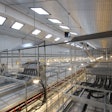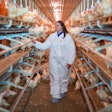
Much of the U.S. egg industry is gradually transitioning to cage-free housing for laying hens. Good pest management is an important part of an egg producer’s food safety program.
Egg Industry Insight asked pest control experts at Liphatech, MGK and Motomco for advice on things egg producers should consider if they are transitioning operations from cage to cage-free housing and how to prevent pests and rodents from entering a facility.
This is the final part of a three-part series and focuses the potential vectors of transportation for pests and rodents into layer houses and egg processing plants, and how to reduce the activity.
1. What steps should be taken to ensure that materials brought into an egg packing plant from outside, like pallets, don’t became a source of rodents and insects?
“Visual inspection is the best way to minimize this risk,” explained Andy Schoenherr (Motomco - Senior Product Manager). He also recommended looking for signs of rodent activity such as chewed materials, urine or droppings, especially on larger pallets where rodents could be nesting.
Jason Price (Liphatech - National Technical Support Manager) advised that materials stored outside should be monitored. “To ensure materials being brought into the facility are free of rodents, the complex would want to be sure they are not stored outside for a period of time or in a facility that does not have a rodent control program in place,” he stated.
To Cassie Krejci (MGK - Technical Specialist), educating employees on what to look for when bringing in crates, pallets or other materials, and conducive conditions in which pests thrive, is critical. “I’ve found that education and communication is key. Inspect everything that comes into the facility with insects in mind; biosecurity is important at the insect level too,” stated Krejci. “Communicating this pest management plan to suppliers can help close any loopholes that allow the entrance of pests. Don’t be afraid to ask questions of your suppliers as to how they handle pest control.
2. What steps should be taken outside poultry houses and egg packing plants to control rodents and insects?
To Schoenherr, exterior baiting is important due to the limited options of baiting the interior of cage-free houses. “We generally recommend more placements on the exterior (stations closer together), or even a ‘2nd perimeter’ away from the buildings, which can legally be done 75-100 feet out. That helps start reducing rodent numbers before they can get more established around the barns,” he explained.
Krejci recommended regular inspections and maintaining rodent stations, as well as quickly repairing any exterior house damages after found. “As urban encroachment becomes as widespread issue, poultry production facilities of all kinds will be under increased scrutiny for how they are controlling insects and rodents. Additionally, she recommended exterior misting systems on the vents of poultry housing for added fly control. “Not only do these systems work to decrease exterior fly pressure, but they are also very visible evidence to urban neighbors that facilities care about how pests may be affecting the area,” she stated.
Schoenherr also noted the relationship between insects and pyrethroid. “Producers also need to pay attention to the insect control being used since most pyrethroids can be sensed or detected and deter them from consuming the bait. We usually recommend using an insecticide with fipronil or dinotefuran,” he stated.
Price advised scheduling the servicing of exterior bait stations and cautioned the importance of doing it correctly. “Exterior bait stations around the buildings serviced and stocked with fresh rodenticide on a weekly or bi-weekly basis is the first line of defense when controlling rodents in and around a farm. However, this requires a thorough job on a routine basis cleaning bait stations and replenishing rodenticide according to the product label directions.”
Additionally, he recommended a rock apron to deter pests and rodents. “Most complexes already have limited grass and are placing rock on the perimeter of the houses. If possible, a three-to-five-foot rock apron around the buildings is best.”
3. Besides pallets, what other potential vectors for bringing pests into egg packing plants need to be considered?
Price said that knowing your surroundings is critical when looking at potential pest activity around the facility. “Besides pallets, other potential vectors could be pallets or bags of feed ingredients on facilities that have feed mills on site.”
Schoenherr advised that understanding rodent movement and motivation is especially important when looking at egg packing plants. “Broken eggs or other food sources may attract rodents, but generally rodents are entering buildings looking for warmth and shelter. Producers need to pay attention to changes in weather or other environmental conditions that may cause rodents to start moving inside,” he explained.
Krejci believes that humans are one of the largest sources of pest presence in facilities due to lack of biosecurity practices. “I have spent substantial time in poultry production over the last couple of years tackling the growing issue of bed bugs and mites in poultry houses,” explained Krejci. “These experiences have led me to believe that humans are some of the biggest vectors we should account for. Bed bugs often come into poultry production on staff members from personal homes. This unknowing infestation can lead to significant losses to production and revenue.”
“Mites are also easily transferred between poultry houses. While they don’t use humans as a host, they can be opportunistic and easily catch a ride from one flock to another on clothing and boots. Improving biosecurity measures like showering in and out and changing suits and booties between houses has proven to drastically cut down on these incidents of insect introduction by human vectors,” stated Krejci.

















